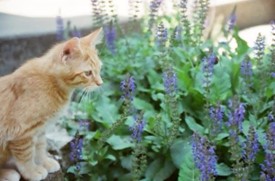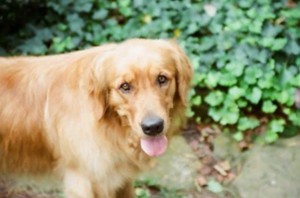Keeping Pets out of Gardens

If you live in town or the country, pets can become nuisances in your flowerbeds and vegetable garden. Whether domestic or feral (wild), dogs and cats can be a real problem for gardeners. Cats can destroy plants and mess up your seedbed. Both defecate and urinate in the garden soil, making the place unpleasant. Cats can serve as a reservoir for diseases that include histoplasmosis, leptospirosis, mumps, plague, rabies, ringworm, salmonellosis, toxoplasmosis, cat scratch fever, and distemper. Cat feces can contain parasites that can affect people's health. It is in the gardener's interest to keep cats out of the garden. Once animals start using your flowerbeds as a restroom, it can seem impossible to get them to stop, but there are some tips and tricks to keep the pesky animals out of your area.
Cats use gardens and flowerbeds as litter boxes because the soil is similar to what they prefer for their kitty litter. Our first step to stopping them is to create a place that doesn’t mimic their preferred restroom. You can use rough-textured mulch in flowerbeds to deter cats from using that area as a litter box. Cats don’t like the feel of rough or larger chunks of mulch. Chicken wire fencing can be laid on the ground in the garden to prevent cats from digging. The wire can be secured with extra-large “hair pins” formed by cutting wire coat hangers in half. Most plants will grow through the wire easily. The wire can be covered with a thin layer of mulch if needed. Floating row covers can be used to cover raised beds or small areas where the cats are digging is limited to a small space. Single or double strands of electric wire on a low voltage can be used around the garden to teach cats that it isn’t a safe space for them. The fence can be turned off once the cats have learned their lesson, but leave it in place as a deterrent. Some repellents can be used, but they might have limited effectiveness. Cats are more active during twilight and nighttime, so freshen repellents and prepare barriers for higher use during those times. To avoid contamination by cats' feces, wear gloves when gardening. Wash your hands and fingernails thoroughly after working in the garden when not using gloves. If a cat has been using your garden as a litterbox, I would hesitate to eat the produce grown in that area.
While having Fido with you when you are working in the garden is a wonderful experience, there are also some less-than-ideal experiences you can have with man’s best friend. You might be less than impressed if your prize flowerbed has become the neighborhood dog’s message board. Due to its high nitrogen content, dog urine can damage and even kill plants over time. Unfortunately, dogs can be harder to repell than cats, but it is possible. Put up a barrier around plants that are being used as a pee spot to make it harder to get to those spots. Some people have found that putting pinecones or other things that are uncomfortable on their paws discourages the dogs from walking there. As with cats, repellents have mixed reviews on whether they work, especially once pets use that area. If you can’t stop them from going in that spot, pick a plant resistant to pet urine to plant there instead.
also some less-than-ideal experiences you can have with man’s best friend. You might be less than impressed if your prize flowerbed has become the neighborhood dog’s message board. Due to its high nitrogen content, dog urine can damage and even kill plants over time. Unfortunately, dogs can be harder to repell than cats, but it is possible. Put up a barrier around plants that are being used as a pee spot to make it harder to get to those spots. Some people have found that putting pinecones or other things that are uncomfortable on their paws discourages the dogs from walking there. As with cats, repellents have mixed reviews on whether they work, especially once pets use that area. If you can’t stop them from going in that spot, pick a plant resistant to pet urine to plant there instead.
Pets are a wonderful part of life, even if they can cause us some headaches along the way. Hopefully, one of these tricks will help you keep roaming pets out of your flowers and garden. Don’t use mothballs or flakes made from naphthalene to repel cats and other pests outside. When used outdoors, the balls and flakes melt and may contaminate groundwater.

Have questions? Contact our office where our Horticulture Extension Agent will assist you with questions.
Phone: (316) 321-9660
Email: callae@ksu.edu